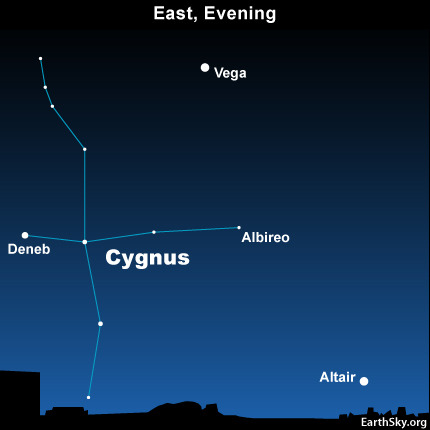Summer Triangle: Deneb and Cygnus the Swan

Tonight for July 18, 2014
Tonight’s chart has you looking eastward at the famous Summer Triangle. Today, notice the star Deneb, the northernmost star in the Summer Triangle. Its constellation is Cygnus the Swan. In a dark country sky, you can see that Cygnus is flying along the starlit trail of the summer Milky Way.
EarthSky’s meteor shower guide for 2014
EarthSky astronomy kits are perfect for beginners. Order yours today.

EarthSky Facebook
friend Annie Lewis in Madrid, Spain captured this photo of the Summer
Triangle, shortly after nightfall on a summer night. In fact, she said,
the only stars visible to the unaided eye when she took the photo were
the three in the Triangle. But her camera knew better. Thanks, Annie.
Okay, I’ve given you a lot of names here: Summer Triangle, Cygnus, Northern Cross.
Just remember, the constellation Cygnus the Swan contains the Northern Cross. The Cross is – more or less – just another way to see the Swan. The Northern Cross is what’s called an asterism, or recognizable pattern within a constellation. In this case, the pattern is the whole constellation, pretty much. At least, I never see them any differently.
Except for one thing. Deneb is at the top of the Cross, but at the tail of the Swan (the star name “deneb” always means “tail”). The little star Albireo is at the head of the Swan, but at the base of the Cross. Whew!
Our Summer Triangle series includes: Vega and its constellation Lyra Deneb and its constellation Cygnus: Altair and its constellation Aquila


No comments:
Post a Comment